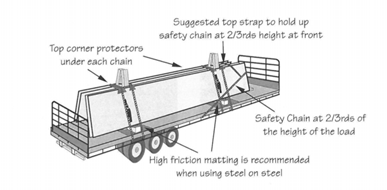Delivery and unloading of pre-cast panels
Issued: 25 January 2012
Last Updated: 25 January 2012
Purpose
The purpose of this alert is to highlight the importance of safe delivery and unloading of pre-cast panels.
Background
On 7 December 2011, an incident occurred that resulted in serious injuries to a truck driver who was delivering pre-cast concrete panels to a civil construction site. One of the pre-cast panels fell from the trailer, trapping the driver.
Contributing factors
It would appear that an appropriate exclusion zone was not established before the panels were released and off-loaded from the vehicle.
Action required
- A work method statement is required for the activity of unloading pre-cast concrete panels from trucks, which is a high risk construction activity. The principal contractor must ensure that the activity of unloading pre-cast concrete panels is done in accordance with the work method statement.
- Doggers and crane operators must maintain the exclusion zone during each lift. This includes knowing where the truck driver is located. The truck driver must not re-enter the exclusion zone until signalled by the crane crew. All other people not involved in unloading the panels must not enter the exclusion zone until all lifts are completed.
- The crane crew is responsible for maintaining the exclusion zone during lifting.
A-frames for carrying concrete panels
- A-frames must be secured to the vehicle.
- The support feet on the A-frame should have high friction rubber between them, the concrete panels and the trailer floor.
- Ensure that the A-frames are not twisted or placed on an uneven floor otherwise the load may rock and move.

Photograph 1
Delivery of panels
- Panels should be restrained on the trailer by a system that ensures the load is evenly distributed and able to withstand movement of the panels during transport. Panels should be loaded and secured so they will not become unstable when the restraint system is released on site (i.e. on an A-frame, the panels lean inwards against the frame).
Unloading of panels
- Panels should be unloaded in a designated area on site. The truck should be located on firm, level ground. The side slope should be less than two degrees (two degrees is usually just noticeable to the human eye). If the risk of the panels falling is controlled by the way the panels are loaded (i.e. the panels are loaded flat on the trailer), the ground slope may be able to be more than two degrees. Consideration must be given to requirements for the movement of plant in the designated area during unloading (i.e. the effects of sloping ground on mobile cranes).
- All people other than those directly involved in the delivery and unloading of the panels must be excluded from the work area (exclusion zone).
- The release of the load restraint, lifting and storage of panels should be done in line with the work method statement. Further information about unloading panels can be found in the Tilt-up and Precast Code of Practice 2003.
- No lifting of panels can start until the truck driver has finished releasing the load restraint, which includes packing up the chains and straps. The truck driver should move out of the work area and directly signal the crane crew that lifting can start.
- The dogger and crane operator must ensure that all other persons, including the truck driver, are outside the exclusion zone before starting any lifts.
Safe work method statements
- The Work Health and Safety Regulation 2011 deems construction work as high risk work, including when the work:
- involves tilt-up and pre-cast concrete; or
- is carried out in an area at a workplace in which there is any movement of powered mobile plant.
- A principal contractor must not allow a relevant person to start high risk construction work unless the relevant person has prepared a safe work method statement (SWMS) for the activity. The principal contractor must also monitor the use of any work method statement to ensure that all people to whom the statement applies comply with it.
SWMS for delivery and unloading of pre-cast panels
Careful consideration must be given to the transport, delivery and unloading of pre-cast concrete panels. Factors to be considered include:
- who is responsible for the various activities
- the truck entering the site
- a traffic control management plan
- where the truck will be positioned for unloading
- the condition of the ground (i.e. stability, level, area i.e. room to move)
- an appropriate exclusion zone
- who is responsible for removal of the load restraint from the panels
- the method/sequence used to unload the truck
- who is involved in unloading the truck (e.g. the crane crew and truck driver).
Further information
Guidance may be sought from the Tilt-up and Pre-cast Construction Code of Practice 2003 (PDF, 0.96 MB).